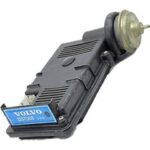The error code P1290 in your BMW indicates a problem with the fuel rail pressure sensor circuit. This is a crucial component in your BMW’s fuel injection system, responsible for monitoring the fuel pressure going to your engine. When your BMW’s computer (DME or ECU) detects that the fuel rail pressure sensor circuit is reporting low input, it triggers the P1290 code, illuminating the check engine light and potentially impacting your vehicle’s performance.
Understanding the fuel rail pressure sensor is key to diagnosing P1290. This sensor, typically located on the fuel rail, sends real-time data about fuel pressure to the DME. The DME uses this information to precisely control the fuel injectors and ensure optimal engine combustion. A malfunction in this system can lead to a range of issues.
Common symptoms associated with the P1290 code include:
- Check Engine Light: This is the most obvious sign, indicating that your BMW’s onboard diagnostics have detected an issue.
- Engine Performance Issues: You might experience hesitation, sputtering, or a general lack of power, especially during acceleration.
- Difficulty Starting: In some cases, low fuel pressure can make it harder to start your BMW, or it might stall shortly after starting.
- Poor Fuel Economy: Inefficient fuel delivery due to pressure issues can lead to increased fuel consumption.
Several factors can trigger the P1290 code. The most common culprits are:
- Faulty Fuel Rail Pressure Sensor: The sensor itself might be defective, providing inaccurate readings to the DME. This is often the primary cause.
- Wiring or Connector Problems: Damage, corrosion, or loose connections in the wiring harness leading to the fuel rail pressure sensor can disrupt the signal.
- Low Fuel Pressure: Issues elsewhere in the fuel system, such as a failing fuel pump or a clogged fuel filter, can cause actual low fuel pressure, which the sensor correctly detects, leading to the P1290 code.
- DME/ECU Issues (Less Common): In rare cases, a problem with the engine control module itself could misinterpret sensor readings or falsely trigger the code.
Diagnosing and resolving P1290 requires a systematic approach. Here’s a step-by-step guide:
-
OBD-II Scan: Use an OBD-II scanner to confirm the presence of the P1290 code and check for any other related codes. This initial scan provides a starting point for diagnosis.
-
Visual Inspection: Carefully inspect the fuel rail pressure sensor, its wiring, and connectors. Look for any signs of damage, corrosion, or loose connections. Pay close attention to the wiring harness for any breaks or frays.
-
Fuel Pressure Test: Use a fuel pressure gauge to manually test the fuel pressure in the system. Compare the reading to BMW’s specifications for your model. Low fuel pressure can indicate a problem with the fuel pump or fuel filter.
-
Fuel Rail Pressure Sensor Test: With a multimeter, you can test the fuel rail pressure sensor’s voltage and resistance. Refer to your BMW repair manual for the correct testing procedures and values. This can help determine if the sensor itself is faulty.
-
Wiring Continuity Test: Use a multimeter to check the continuity of the wiring between the fuel rail pressure sensor and the DME. This can identify any breaks or shorts in the wiring.
If you suspect a faulty fuel rail pressure sensor, replacement is often the next step after confirming the sensor is indeed the issue and not an underlying wiring or fuel delivery problem. You can typically find replacement sensors at automotive parts retailers or BMW dealerships.
https://www.fcpeuro.com/products/bmw-fuel-pressure-sensor-13627585288
Replacing the sensor is generally a straightforward process:
- Disconnect the negative battery terminal for safety.
- Locate the fuel rail pressure sensor on the fuel rail.
- Disconnect the electrical connector from the sensor.
- Carefully unscrew and remove the old sensor. Be prepared for a small amount of fuel spillage.
- Install the new fuel rail pressure sensor, ensuring it is properly tightened.
- Reconnect the electrical connector.
- Reconnect the negative battery terminal.
- Clear the P1290 code using an OBD-II scanner.
- Start the engine and check for any leaks and to ensure the code does not return.
Addressing the P1290 code promptly is important to maintain your BMW’s performance and fuel efficiency. While some troubleshooting steps can be performed by a DIY enthusiast, if you are uncomfortable with fuel system diagnostics or repairs, it is always best to consult a qualified BMW technician to ensure accurate diagnosis and repair.
